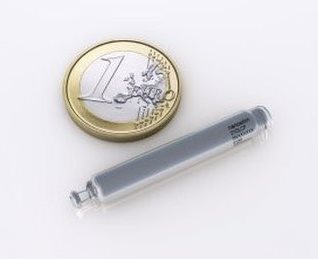First UK patient receives Nanostim pacemaker implanted in heart through femoral vein
28 January 2014
St Bartholomew’s Hospital in London has implanted the first patient in the UK with the St Jude Medical Nanostim leadless pacemaker.
The Nanostim pacemaker is implanted in the heart via the femoral vein using a steerable catheter. It is designed to be fully retrievable so that it can be readily repositioned throughout the implant procedure and later retrieved if necessary. The device offers a less-invasive approach for physicians compared to traditional pacemaker procedures that require more invasive surgery.
Maureen McCleave, a 77-year-old from Chingford, became the first recipient of the Nanostim. Having dealt with persistent atrial fibrillation for over a decade, Maureen often experienced periods of dizziness and fatigue that prevented her from participating in routine activities. In some extreme cases, her abnormal heart rhythm resulted in episodes where her heart would stop beating for up to five seconds at a time. Maureen’s procedure took just eight minutes to perform; she is already feeling more energetic and is looking forward to a full recovery.

The Nanostim pacemaker
"Nanostim is one of the most significant advancements in cardiology and pacemaker technology," said Professor Schilling, consultant at Barts Health NHS Trust. "This miniaturized, minimally-invasive cardiac pacemaker offers my patients the potential for reduced complications like infection and aesthetic benefits over conventional pacemakers, in addition to quicker recovery times. We are delighted to have conducted the first implants of this ground-breaking technology at St Bartholomew’s Hospital."
The Nanostim leadless pacemaker is less than 10% the size of a conventional pacemaker. The small size of the device and lack of a surgical pocket, coupled with the exclusion of a lead, improves patient comfort and can reduce complications, including device pocket-related infection and lead failure. The elimination of the visible lump and scar at a conventional pacemaker’s implant site, in addition to the removal of patient activity restrictions that may prevent the dislodgement or damage to a conventional lead, will potentially improve the quality of life for patients with this technology by allowing most to continue living active, uninhibited lifestyles. The device is supported by the St. Jude Medical Merlin Programmer, which is also used to interrogate and program the company’s other pacemakers and implantable cardioverter defibrillators (ICDs).
“The first post-approval implant in the UK is an important step for this revolutionary technology platform and a proud addition to St. Jude Medical’s strong history in pacing innovation,” said Paul Turner, vice president of St Jude Medical UK “By providing a smaller, leadless pacing technology, physicians will now be able to offer patients a device that upholds the accuracy of conventional pacemaker technology via a minimally invasive procedure.”
Initial results from the LEADLESS study, a prospective, single-arm, multicenter study evaluating patients with the Nanostim leadless pacemaker, were presented earlier this year and demonstrated overall device performance comparable to conventional pacemakers. Total implant procedure times averaged 28 minutes. Even with miniaturization, the device battery is expected to have an average lifespan of more than nine years at 100%t pacing, or more than 13 years at 50% pacing.
Cardiac pacemakers are used to treat bradycardia, which is a heart rate that is too slow. These devices monitor the heart and provide electrical stimulation when the heart beats too slowly for each patient's specific physiological requirements. More than 4 million people worldwide have an implanted pacemaker or other cardiac rhythm management device, and an additional 700,000 patients receive the devices each year.